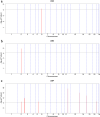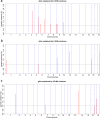A composite strategy of genome-wide association study and copy number variation analysis for carcass traits in a Duroc pig population
- PMID: 35964005
- PMCID: PMC9375371
- DOI: 10.1186/s12864-022-08804-1
A composite strategy of genome-wide association study and copy number variation analysis for carcass traits in a Duroc pig population
Abstract
Background: Carcass traits are important in pig breeding programs for improving pork production. Understanding the genetic variants underlies complex phenotypes can help explain trait variation in pigs. In this study, we integrated a weighted single-step genome-wide association study (wssGWAS) and copy number variation (CNV) analyses to map genetic variations and genes associated with loin muscle area (LMA), loin muscle depth (LMD) and lean meat percentage (LMP) in Duroc pigs.
Results: Firstly, we performed a genome-wide analysis for CNV detection using GeneSeek Porcine SNP50 Bead chip data of 3770 pigs. A total of 11,100 CNVs were detected, which were aggregated by overlapping 695 CNV regions (CNVRs). Next, we investigated CNVs of pigs from the same population by whole-genome resequencing. A genome-wide analysis of 21 pigs revealed 23,856 CNVRs that were further divided into three categories (851 gain, 22,279 loss, and 726 mixed), which covered 190.8 Mb (~ 8.42%) of the pig autosomal genome. Further, the identified CNVRs were used to determine an overall validation rate of 68.5% for the CNV detection accuracy of chip data. CNVR association analyses identified one CNVR associated with LMA, one with LMD and eight with LMP after applying stringent Bonferroni correction. The wssGWAS identified eight, six and five regions explaining more than 1% of the additive genetic variance for LMA, LMD and LMP, respectively. The CNVR analyses and wssGWAS identified five common regions, of which three regions were associated with LMA and two with LMP. Four genes (DOK7, ARAP1, ELMO2 and SLC13A3) were highlighted as promising candidates according to their function.
Conclusions: We determined an overall validation rate for the CNV detection accuracy of low-density chip data and constructed a genomic CNV map for Duroc pigs using resequencing, thereby proving a value genetic variation resource for pig genome research. Furthermore, our study utilized a composite genetic strategy for complex traits in pigs, which will contribute to the study for elucidating the genetic architecture that may be influenced and regulated by multiple forms of variations.
Keywords: Carcass traits; Copy number variation; GWAS; Pigs.
© 2022. The Author(s).
Conflict of interest statement
The authors declare that they have no competing interests.
Figures





Similar articles
-
Genome-wide detection of CNV regions and their potential association with growth and fatness traits in Duroc pigs.BMC Genomics. 2021 May 8;22(1):332. doi: 10.1186/s12864-021-07654-7. BMC Genomics. 2021. PMID: 33964879 Free PMC article.
-
A genome-wide single nucleotide polymorphism and copy number variation analysis for number of piglets born alive.BMC Genomics. 2019 Apr 27;20(1):321. doi: 10.1186/s12864-019-5687-0. BMC Genomics. 2019. PMID: 31029102 Free PMC article.
-
Copy Number Variation and Selection Signal: Exploring the Domestication History and Phenotype Differences Between Duroc and the Chinese Native Ningxiang Pigs.Int J Mol Sci. 2024 Oct 31;25(21):11716. doi: 10.3390/ijms252111716. Int J Mol Sci. 2024. PMID: 39519268 Free PMC article.
-
Genome wide copy number variations using Porcine 60K SNP Beadchip in Landlly pigs.Anim Biotechnol. 2023 Nov;34(6):1891-1899. doi: 10.1080/10495398.2022.2056047. Epub 2022 Apr 4. Anim Biotechnol. 2023. PMID: 35369845 Review.
-
DNA methylation episignatures: insight into copy number variation.Epigenomics. 2022 Nov;14(21):1373-1388. doi: 10.2217/epi-2022-0287. Epub 2022 Dec 20. Epigenomics. 2022. PMID: 36537268 Review.
Cited by
-
Cis-eQTL Analysis and Functional Validation of Candidate Genes for Carcass Yield Traits in Beef Cattle.Int J Mol Sci. 2022 Dec 1;23(23):15055. doi: 10.3390/ijms232315055. Int J Mol Sci. 2022. PMID: 36499383 Free PMC article.
-
Genome-wide association studies for economically important traits in mink using copy number variation.Sci Rep. 2024 Jan 2;14(1):24. doi: 10.1038/s41598-023-50497-3. Sci Rep. 2024. PMID: 38167844 Free PMC article.
-
Finding Predictors of Leg Defects in Pigs Using CNV-GWAS.Genes (Basel). 2023 Nov 8;14(11):2054. doi: 10.3390/genes14112054. Genes (Basel). 2023. PMID: 38002997 Free PMC article.
-
A genome-wide association study for loin depth and muscle pH in pigs from intensely selected purebred lines.Genet Sel Evol. 2023 Jun 15;55(1):42. doi: 10.1186/s12711-023-00815-0. Genet Sel Evol. 2023. PMID: 37322449 Free PMC article.
-
Whole-genome sequencing reveals copy number variations and their associations with body weight and size traits at slaughter in Lion-head geese.Poult Sci. 2025 Mar;104(3):104892. doi: 10.1016/j.psj.2025.104892. Epub 2025 Feb 7. Poult Sci. 2025. PMID: 39965273 Free PMC article.
References
-
- Sanchez MP, Riquet J, Iannuccelli N, Gogué J, Billon Y, Demeure O, Caritez JC, Burgaud G, Fève K, Bonnet M, et al. Effects of quantitative trait loci on chromosomes 1, 2, 4, and 7 on growth, carcass, and meat quality traits in backcross Meishan x Large White pigs. J Anim Sci. 2006;84(3):526–537. doi: 10.2527/2006.843526x. - DOI - PubMed
MeSH terms
Grants and funding
- 2016YT03H062/Guangdong Yang Fan Innovative and Entrepreneurial Research Team Program
- 200-2018-XMZC-0001-107-0145/Guangdong Province Rural Revitalization Strategy Special Project
- 31972540/National Natural Science Foundation of China
- 2019BT02N630/Local Innovative and Research Teams Project of Guangdong Province
LinkOut - more resources
Full Text Sources
Miscellaneous

